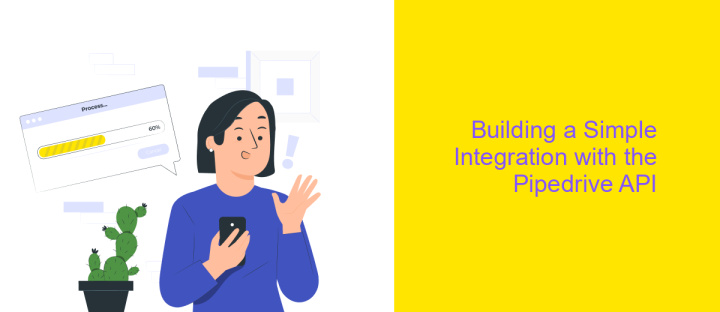Pipedrive API Integration
Pipedrive API Integration empowers businesses to streamline their sales processes by connecting their existing systems with Pipedrive's robust CRM platform. By leveraging the API, companies can automate workflows, synchronize data, and enhance collaboration across teams. This integration not only boosts efficiency but also provides valuable insights into customer interactions, enabling more informed decision-making. Discover how Pipedrive API Integration can transform your sales strategy and drive business growth.
Introduction to Pipedrive and its API
Pipedrive is a powerful customer relationship management (CRM) tool designed to help businesses streamline their sales processes and close deals more efficiently. With its intuitive interface and robust features, Pipedrive allows sales teams to manage leads, track communications, and automate repetitive tasks. Its visual sales pipeline makes it easy to see where each deal stands and what actions are needed to move it forward, ensuring that no opportunity is overlooked.
- Easy-to-use interface that boosts productivity
- Customizable pipelines to fit unique sales processes
- Integration with over 150 apps for enhanced functionality
- Powerful reporting tools for data-driven decision making
- Mobile app for managing sales on the go
The Pipedrive API extends the platform's capabilities by allowing developers to integrate it with other applications and create custom solutions. This API provides access to essential CRM features, enabling businesses to automate workflows, sync data across platforms, and build tailored tools that enhance their sales processes. With comprehensive documentation and a supportive developer community, the Pipedrive API is an invaluable resource for businesses looking to maximize the potential of their CRM system.
Setting up Your Pipedrive API Access

To begin setting up your Pipedrive API access, first log in to your Pipedrive account. Navigate to the 'Settings' menu, and from there, select 'API' to find your personal API token. This token is crucial as it acts as a key to access Pipedrive's data and functionalities. Ensure you store this token securely, as it grants full access to your account's data. If you're collaborating with a development team, share this token with them to facilitate the integration process.
For those looking to streamline the integration process without extensive coding, consider using ApiX-Drive. This platform simplifies the connection between Pipedrive and other applications, enabling seamless data flow with minimal technical know-how. ApiX-Drive offers a user-friendly interface to set up automation, reducing the need for manual data entry and ensuring your sales pipeline remains up-to-date. By leveraging such tools, you can enhance your CRM capabilities, improve efficiency, and focus more on strategic tasks rather than technical setup.
Key Pipedrive API Features and Use Cases

The Pipedrive API offers a robust suite of features that streamline customer relationship management and enhance productivity for businesses. With its intuitive design, the API allows developers to seamlessly integrate Pipedrive's functionalities into various applications, providing real-time access to essential CRM data.
- Contact Management: Easily manage and update contact information, ensuring that your CRM data is always current and accurate.
- Deal Tracking: Automate deal updates and track progress, allowing sales teams to focus on closing deals rather than administrative tasks.
- Activity Management: Schedule and manage activities such as calls and meetings, ensuring that no opportunity is missed.
- Customizable Pipelines: Create and modify sales pipelines to match your business processes, providing flexibility and control over your sales strategy.
- Data Insights: Generate detailed reports and analytics to gain valuable insights into sales performance and make data-driven decisions.
These features make Pipedrive API a powerful tool for businesses looking to enhance their CRM capabilities. By leveraging these functionalities, companies can improve their sales efficiency, foster better customer relationships, and ultimately drive growth. Whether automating routine tasks or gaining deeper insights into sales data, Pipedrive API serves as a versatile solution for modern businesses.
Building a Simple Integration with the Pipedrive API

Integrating with the Pipedrive API allows businesses to streamline their CRM processes by automating tasks and syncing data across platforms. To build a simple integration, you need a basic understanding of RESTful APIs and access to a Pipedrive account. The Pipedrive API uses JSON for data exchange and requires an API token for authentication.
Start by setting up your development environment with the necessary tools and libraries. You can use programming languages like Python, JavaScript, or PHP, depending on your preference. Ensure you have the Pipedrive API documentation handy to understand the endpoints and data structures involved.
- Obtain your Pipedrive API token from your account settings.
- Set up HTTP requests to interact with Pipedrive's API endpoints.
- Test your integration using tools like Postman or curl to ensure data is correctly sent and received.
- Implement error handling to manage API limits and potential issues.
Once your integration is functional, you can extend its capabilities by adding features such as automated data entry, custom reporting, or synchronization with other business tools. Regularly monitor your integration's performance and update it in line with any changes to the Pipedrive API.
- Automate the work of an online store or landing
- Empower through integration
- Don't spend money on programmers and integrators
- Save time by automating routine tasks
Best Practices and Troubleshooting for Pipedrive API Integration
When integrating with the Pipedrive API, it is crucial to adhere to best practices to ensure a seamless and efficient process. Begin by thoroughly reviewing the Pipedrive API documentation to understand its capabilities and limitations. Use version control for your code to manage changes effectively, and always test API calls in a development environment before deploying them live. Implement robust error handling to gracefully manage any unexpected responses or failures. Additionally, consider using tools like ApiX-Drive to streamline the integration process, as it offers a user-friendly interface and automates data flow between different applications, reducing manual intervention and potential errors.
Troubleshooting Pipedrive API integration issues often involves identifying and resolving common errors. Ensure that your API keys are correctly configured and have the necessary permissions. Check for any rate limits imposed by Pipedrive, as exceeding these can cause disruptions. Monitor API logs to track requests and responses, which can help diagnose issues quickly. If problems persist, consult the Pipedrive community forums or support for guidance. Regularly updating your integration with the latest API changes can also prevent compatibility issues. By following these practices, you can maintain a robust and efficient integration with Pipedrive.
FAQ
What is Pipedrive API Integration?
How can I start integrating Pipedrive with other applications?
What are the benefits of using Pipedrive API Integration?
Are there any tools available to simplify Pipedrive API Integration?
What should I consider when integrating Pipedrive with other systems?
Do you want to achieve your goals in business, career and life faster and better? Do it with ApiX-Drive – a tool that will remove a significant part of the routine from workflows and free up additional time to achieve your goals. Test the capabilities of Apix-Drive for free – see for yourself the effectiveness of the tool.


